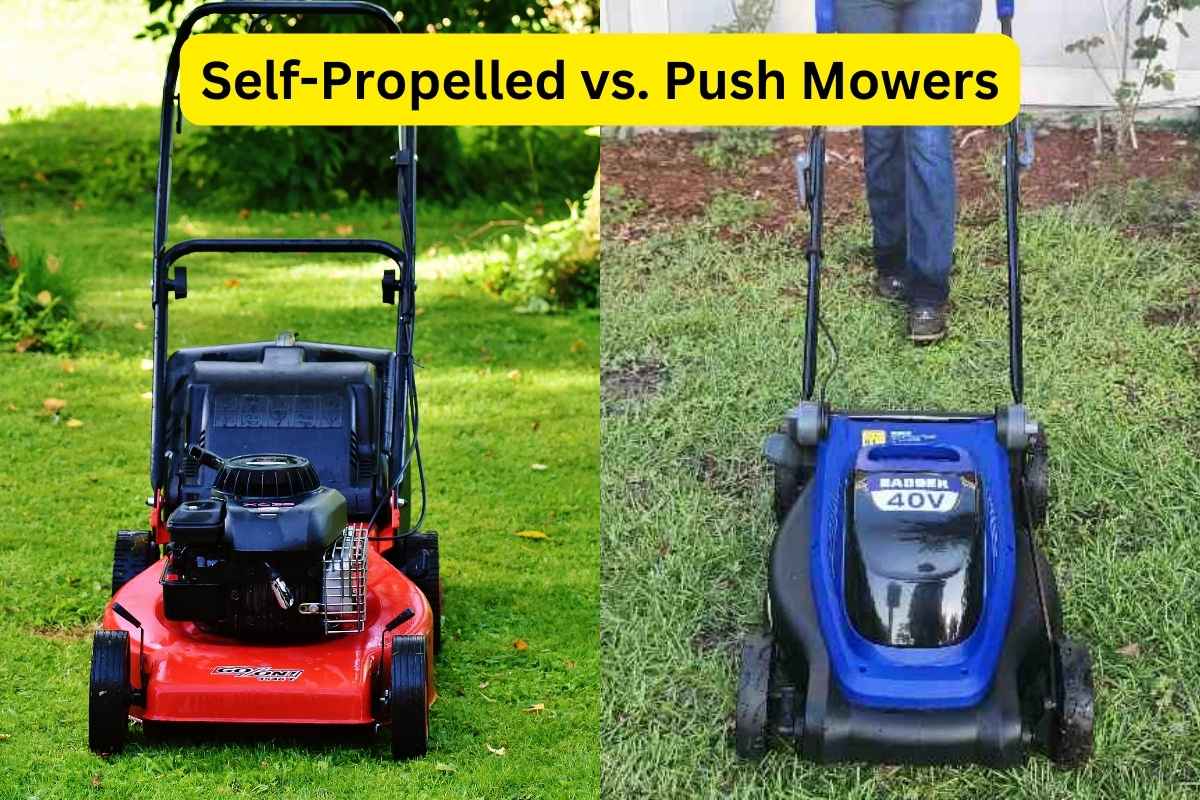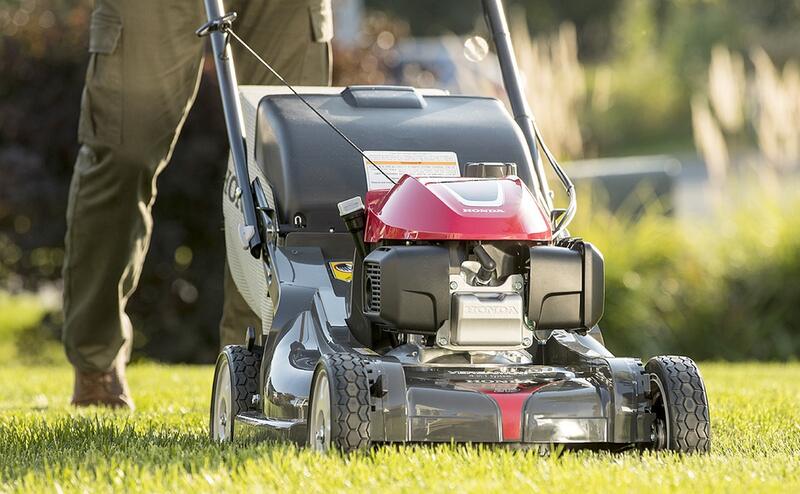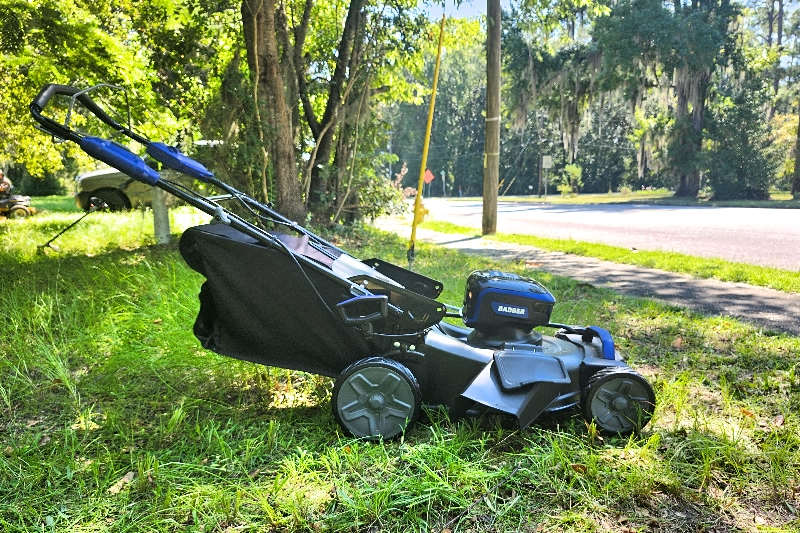
Whether to choose a self-propelled vs. push mower is a long-standing debate among lawn care enthusiasts. Both types are dependable, efficient, and affordable, but choosing the right one for you depends on your yard and your needs.
Self-propelled mowers advance automatically via a drive system, have more powerful engines, and save time and effort when mowing large, bumpy lawns. Push mowers, on the other hand, require body force to move but are more precise and maneuverable on lawns with a lot of obstacles.
We explore all the essential differences between self-propelled and push mowers to provide you with the information you need to select the right mower for your lawn.
What is a Self-Propelled Mower?


Photo Credit: Pixabay
| Key Features of a Self-Propelled Mower | |
| ✓ Drive system ✓ Enhanced engine power to support propulsion and cutting blades ✓ Variable speed (in some models) ✓ Drive control mechanism on the handlebar ✓ Different wheel drive configurations (front-wheel, rear-wheel, and all-wheel drive) |
Like cars, self-propelled (SP) mowers feature a drive system that moves them forward. They use a gas engine or electric motor (battery-powered or powered via a cord and electrical outlet) to spin the wheels and cut the grass.
Depending on the model, the drive system can be controlled with a bail bar, a lever, or a handle installed on the handlebar.
Because of their engine-assisted propulsion, SP mowers simplify mowing medium to large lawns (over 1/4 acre), grass on bumpy terrain, and unkept, tall turf. They put less strain on your body and are more stable on hills and inclines. At 5 1/2 feet, I’d prefer a self-propelled. Don’t get me wrong, exercising is important, but I’d rather swim or jog than push a mower up the hill.
Note: You can also choose to have your lawn mowed by a lawn care professional and avoid the effort altogether.
See Related:
What is a Push Mower?


| Key Features of a Push Mower | |
| ✓ Dedicated cutting power (100% of engine power is used by the blades) ✓ Simplified controls ✓ Lightweight design ✓ Direct steering response ✓ Lower maintenance requirements |
A push mower uses your physical force to move across the lawn. It moves only as fast and as far as you push it while walking behind it.
If it’s a 100% manual mower (e.g., a reel mower), your effort is also the driving power that moves the blades and cuts the grass.
Electric and gas-powered push mowers are fitted with an electric motor or gas engine that rotates the cutting blades (but it’s not connected to the wheels).
Push mowers are ideal for small lawns with level terrain where they don’t need to fight gravity. They are available in reel models (cylindrical blades that spin vertically, offering a cleaner cut — best on short, regularly maintained grass) and rotary models (blades that spin horizontally — best for cutting tall grass).
See Related:
Head-to-Head Comparison
| Self-Propelled Mower | Push Mower | |
| Ease of Use | – Easier to use overall (medium and large lawns, flat and rough terrain, thick, tall grass) | – Easy to use on small (under 1/4 acre), flat, regularly maintained lawns – Physically straining on large lawns and rough terrain |
| Fuel Efficiency | – Uses more fuel because of the propulsion system | – High efficiency; only uses fuel to move the blades |
| Speed and Efficiency | – Faster mowing – Steady speed at 3-4mph – Consistent cutting |
– Slower mowing – Variable speed depending on the operator’s pace – Speed might decrease as the operator grows tired |
| Power | – 140 to 220cc (gas-powered) – 20 to 120V (battery-powered) |
– 125 to 160cc (gas-powered) – 20 to 60V (battery powered) |
| Weight and Maneuverability | 45 to 110 lbs. Harder to turn, back up, and steer around obstacles |
35 to 65 lbs. Easier to maneuver in tight spots and around obstacles |
| Available Features | Special features and gadgets | Basic features |
| Maintenance | High maintenance | Low maintenance |
| Average Cost | $330 to $2,200 | $130 to $800 |
Ease of Use
Winner: Self-propelled
- Self-propelled: Mowers with self-propulsion reduce physical strain and are easier to use overall. You can enjoy easy mowing whether you’re fit enough to run the New York City Marathon or have back and knee problems.
- Push: Push lawn mowers have a simpler design and fewer controls. Many homeowners find their straightforward operation more convenient for a small, flat lawn than a self-propelled mower with additional drive controls demanding attention.
See Related: 9 Best Lawn Mowers for Big Yards [Reviews]
Fuel Efficiency
Winner: Push mower
- Push: Push lawn mowers are more fuel-efficient because they are lighter and use power only for blade rotation. In their case, you’re the engine that powers propulsion and takes on most of the mechanical effort.
Pro Tip: To save fuel and physical energy, mow the lawn regularly, avoid cutting wet grass (it clumps under the deck), and cut only 1/3 of the blade’s length.
See Related:
Speed and Efficiency


Photo Credit: Michelle Selzer
Winner: Self-propelled
- Self-propelled: Most self-propelled models reach 3 to 4 mph and keep a steady speed even on moderate inclines (especially gas-powered mowers).
This consistent pace ensures a more even cut and faster mowing than push mowers. Even so, if your lawn is over 1/2 acre, mowing can take a while, and you should consider a riding mower or a zero-turn mower.
- Push: When mowing with a push mower, the speed depends on your force to push and ability to keep a steady pace. Most people can sustain 3 mph initially but will tire and reduce speed with time and when climbing on inclines.
Overall, a push mower usually takes longer to mow a lawn, and the variable speed can lead to inconsistent cutting. It’s why push mowers are not practical for lawns larger than 1/3 to 1/4 acre — mowing simply takes too long.
Power
Winner: Self-propelled
- Self-propelled: Self-propelled mowers have higher power — between 140cc and 220cc for gas-powered models and 20V to 120V for battery-powered models.
Add the wider blades and the extra weight, which provide more stability on bumpy terrain, and you get the right tool for mowing overgrown lawns with uneven landscapes.
- Push: Walk-behind push lawn mowers have smaller engines, typically between 125cc and 160cc for gas and 20V to 60V for battery-powered options. They are ideal for homeowners who keep a tight mowing schedule and don’t have to deal with tall, wild grass.
Weight and Maneuverability
Winner: Push mower
- Self-propelled: Self-propelled mowers are less maneuverable due to their weight and the need to disengage the drive system and give the mower a slight nudge forward before changing direction.
They are heavier (45 pounds to 160 pounds) because of the drive gearbox, a stronger frame, and additional drive system hardware. On the upside, you don’t need to push the mower’s weight while mowing, so most of the time, you won’t feel it. To improve maneuverability, choose:
- Front-wheel drive if you need to steer around many obstacles (it also simplifies turnaround).
- Rear-wheel drive if your lawn has slopes and hills (it provides more stability).
Available Features
Winner: Self-propelled
- Self-propelled: Self-propelled mowers are typically upgrades to push-mower models in a manufacturer’s product lineup. They feature premium functions that improve efficiency and comfort (and increase the price).
- Push: Push mowers provide core functions at an accessible price, focusing on simple and reliable use.
| Self-Propelled Mowers | Push Mowers | |
| Cutting Width | 18 to 33 inches | 13 to 22 inches |
| Height Adjustment | 6 to 9 positions | 4 to 6 positions |
| Cutting Options | – Bagger (20- to 30-gallon bags) – Advanced mulching technology (cuts grass clippings multiple times) – Side/Rear discharge – Leaf shredding |
– Bagger (15- to 20-gallon bags) – Basic mulching capabilities (cuts grass clippings once) – Side discharge on some models |
| Speed Control | – Variable speed control – Smart drive systems that adapt to walking speed – Cruise control (maintain a constant speed without constant grip pressure) |
N/A |
| Propulsion | Drive type options: front-wheel, rear-wheel, and all-wheel | Manual |
| Special Features | – Single-point blade height adjustment – Ergonomic handle design/Folding handles – Easy-start systems – Deck wash ports – Enhanced airflow for better clipping collection – Blade override systems (runs with blades stopped to cross no-grass areas) – Digital display for speed and battery – Vertical storage design |
– Single-point blade height adjustment – Ergonomic handle design/Folding handles – Easy-start systems – Deck wash ports |
See Related:
Maintenance
Winner: Push mower
See Related:
Cost


Winner: Push mower
- Self-propelled: As you might expect, self-propelled mowers are more expensive. A new self-propelled mower ranges from $330 to over $2,200 for premium models.
The higher cost is due to self-propelled mowers’ more powerful engines, stronger frames to support their heavier weight, elaborate drive systems, and special features.
- Push: A push mower is the more affordable option. A low-end push mower costs $130, while premium models usually cost $600 to $800. Manual reel mowers cost even less, with low-end models available at $60.
Push mowers have lower prices because of their simpler structure. They include lighter frames, fewer components, and less powerful engines.
Note: Check the prices for all types of mowers in our pricing guide: How Much Does a Lawn Mower Cost in 2025?
See Related:
Who Should Choose a Self-Propelled Lawn Mower?
Choose a self-propelled lawn mower if:
- You don’t want to sweat while mowing the lawn, lack the physical strength to drive a push mower all over the yard, or have back problems.
- Own a lawn over 1/4 acre.
- Have a hilly lawn with slopes.
- Grow a thick lawn with coarse-bladed grass like St. Augustine or Bermudagrass.
- Don’t have time to mow the lawn regularly, so you often mow tall grass.
Who Should Choose a Push Mower?
Choose a push mower if you:
- Maintain a small lawn, under 1/4 acre, with a flat terrain.
- Need to mow around many obstacles.
- Prefer a simpler tool with fewer controls.
- Have a limited budget for buying and maintaining a mower.
- Are in good health and fitness.
- Like to have perfect control over the mower — speed and steer.
- Keep a tight mowing schedule, and the turfgrass rarely grows too tall.
FAQ
On average, push mowers last longer than self-propelled mowers because they have fewer parts that can fail, no drive components to wear out, and the engine experiences a lower mechanical strain.
All mowers have lower efficiency on wet grass, but self-propelled mowers can handle it better than push mowers. The upper hand comes from the better traction drive wheels provide, with less slipping and a more effective bagging system.
While new high-voltage models (60 to 80V) perform almost as well as gas models, electric models still fall short in some situations. For example, they can’t sustain the maximum power for long and will have difficulty mowing up hills or thick grass for extended periods.
Self-propelled mowers are better for bagging grass clippings. They feature larger, sturdier bags with more secure mounting systems and improved airflow channels that more effectively collect grass clippings. Also, because of the drive system, mowing speed and consistency are not influenced by a heavy, filled bag.
Leave the Mowing to the Pros
There’s always the third choice: Leave the mowing to our lawn care pros and enjoy your perfectly manicured lawn. Find a LawnStarter pro near you and ensure your lawn receives the best care with no effort on your part.
LawnStarter pros are only a few clicks away and can provide more than spotless weekly (or biweekly) mowing. Dethatching, aeration, leaf removal, fertilization, grass seeding, and installing sod are a few of the tasks our pros can take off your plate.
Main Image Credits:
Self-Propelled Mower: Rawpixel / CC0 1.0
Wild Badger Push Mower: Michelle Selzer
* LawnStarter participates in the Amazon Services LLC Associates Program, an affiliate advertising program. LawnStarter may earn revenue from products promoted in this article.
Sinziana Spiridon
Sinziana Spiridon is an outdoorsy blog writer with a green thumb and a passion for organic gardening. When not writing about weeds, pests, soil, and growing plants, she’s tending to her veggie garden and the lovely turf strip in her front yard.







